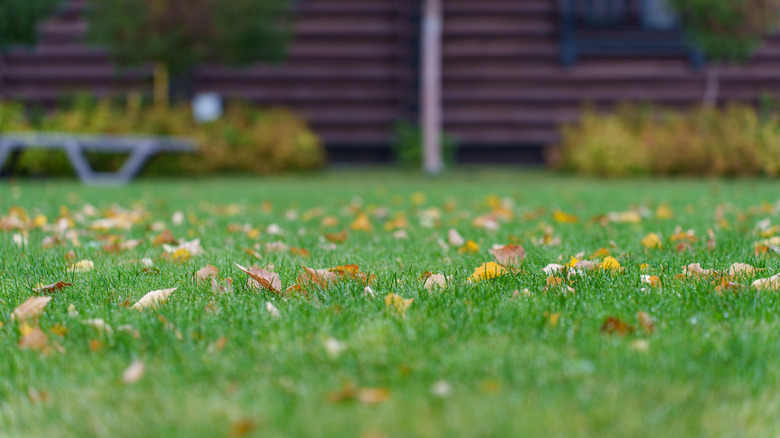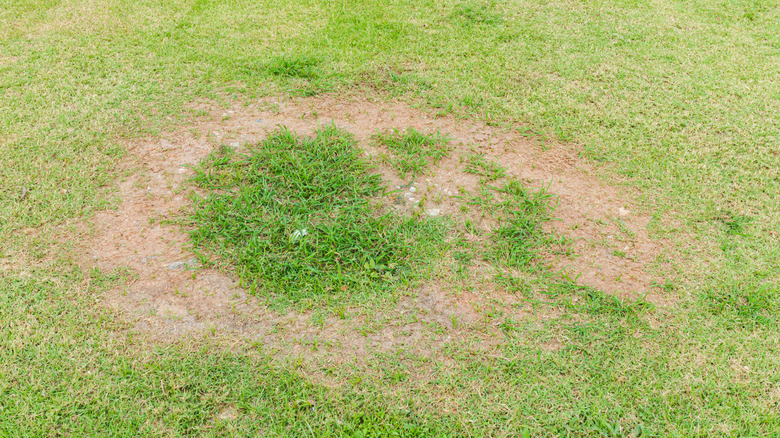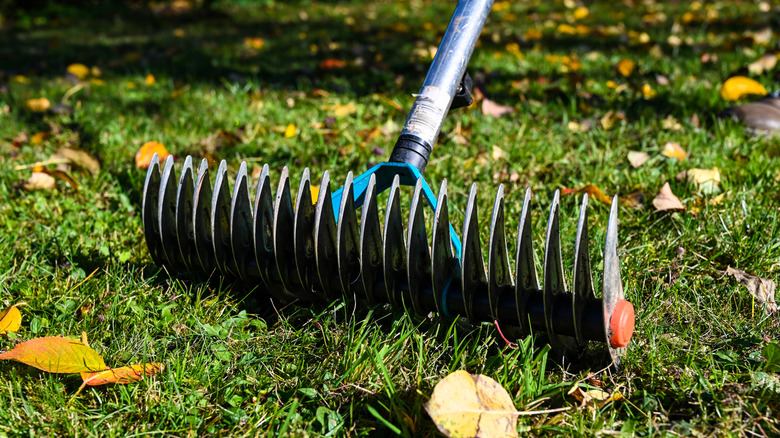The Grass Disease That Could Destroy Your Lawn Before This Winter
For homeowners who take great pride in their lawn, the first sign of thin or discolored patches in the grass is cause for panic. If your yard contains a warm-season grass, such as St. Augustine or zoysia, there's a good chance these spots could be symptoms of large patch, a chronic fungal disease that can cause considerable crown and root damage to your grass. Because it thrives in cool, wet conditions, it is usually most obvious in the fall. However, you may also see signs of large patch in early spring. Unfortunately, the fungus spreads so easily in fall conditions that your lawn may be completely overtaken by winter. That's why maintaining your lawn properly in the fall with proper fertilization, watering, aerating, and mowing is crucial if you want to prevent large patch.
Large patch is caused by strains of the Rhizoctonia solani fungus. It is a soil-borne disease and generally occurs when soil temperatures are below 70 degrees Fahrenheit. While the fungus can survive the summer heat, it obviously thrives in the cooler fall weather. Wet conditions also play a role, so your lawn is most susceptible to fungus like Rhizoctonia solani if its soil doesn't drain properly. Large patch usually spreads through your lawn's thatch layer, eventually making its way to the roots and stems of the grass.
Symptoms of large patch
Large patch symptoms are usually easy to spot, especially once the disease is advanced. The initial signs are typically individual grass blades becoming discolored, which can often go unnoticed. However, as the disease progresses, your lawn develops well-defined circular or semi-circular patches that are impossible to miss. These patches are usually yellow, but they have a darker border, often brown or orange. You may also notice thinning grass in these patches, which can even take on a sunken appearance.
Grass infected with large patch often experiences rot at the base of the leaves, which can appear dark and slimy if you examine them closely. As a result, you'll also find that you can easily pull the blades free from the stems. Additionally, the leaves closest to the soil often have brown, yellow, orange, or red lesions. The diameter of the areas of your lawn affected by large patch can be just a few inches wide, but they can grow to as wide as 20 feet if the fungus continues to spread. As the patches become larger, entire sections of your lawn may appear dead.
Fall lawn maintenance to prevent large patch
Large patch is difficult to get rid of once it infects your lawn, so prevention is the best management method. The way you care for your grass in the fall can go a long way in keeping it protected. Because it thrives in wet conditions, ensuring your lawn is watered correctly is essential. In cool fall weather, avoid overwatering. Water only when necessary, and just in the mornings, so the lawn has time to dry before temperatures drop.
Improving your lawn's drainage can also help prevent large patch. If its thatch is thicker than a ½ inch, dethatch your lawn with a dethatching rake or a power rake. Removing this thick layer of dead grass and other organic material from the soil's surface allows water to be absorbed more easily, keeping your grass drier. You should also aerate your lawn if the soil is compacted. When soil is tightly packed, there isn't space between the particles for water to flow through it freely. Aerating removes small plugs of soil to create openings, so puddles don't build up on the surface.
Additionally, be sure to mow your grass to a height of 2 to 2 ½ inches. Scalping it, or cutting it too short, can stress your lawn, making it more susceptible to fungus. Don't feed your grass with quick-release nitrogen-based fertilizers, either. Nitrogen helps encourage growth, so giving your lawn too much can lead to new blades that are more vulnerable to large patch.


